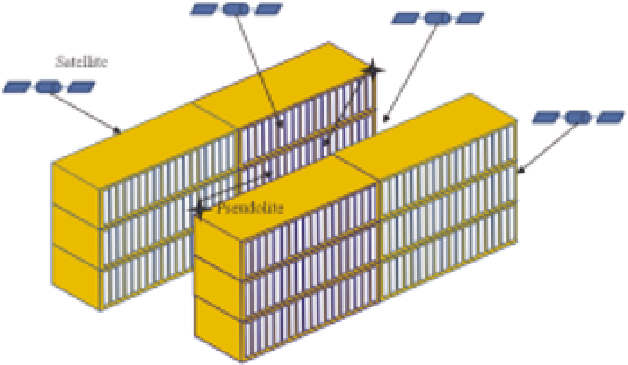Global Positioning System Reference
In-Depth Information
Similar to the open cast mine, the case of modern so-called “urban canyons” are complex
environments for GNSS signals (see figure 5). A receiver located between large buildings
has some difficulties acquiring a sufficient number of satellites. When having additional
signals from judiciously located pseudolites, a normal situation can be obtained, leading to
the positioning of the receiver in these kinds of environments.
In the previous three examples, the pseudolite is used in order to “augment” the GPS
system, its coverage or its accuracy. But one can push forward the concept towards a
completely new system: this was imagined for positioning the Mars rover. A complete set of
several pseudolites was deployed on the surface of the planet and the signals used for
positioning, the same way it is achieved with GPS signals from space. Based on this idea, it
was thought that an indoor positioning system could be designed.
Fig. 5. The urban canyon configuration
3.3 The system for indoor positioning
The basic idea is indeed very simple and is based on the construction of a local terrestrial
constellation of GNSS-like signal generators (Kee et al. 2003). They are located at the corners
of the building in order to simulate satellites. Figure 6 is a typical distribution although not
optimal since the DOP is not very good (please refer to the discussion in previous sections).
This is nevertheless a good basis for understanding the concept.
Some major differences apply with comparison to satellites, the most important ones being
the immobility of the pseudolites and the shorter distances between the pseudolites and the
receiver (leading to unambiguous code for instance, as will be discussed in the next section).
As discussed in previous sections, one has to take care of the initial location considered in
the computations of the receiver location since the two possible solutions
11
are not so far
11
Remember that four transmitters are used for geometrical (three) and synchronization (one) purposes.
The intersection of the surfaces of three spheres gives two points located symmetrically apart from a
plane that includes the three transmitters (this comes from the form of the equations that are non-
linear). Thus, in case of local transmitters, the final location obtained depends on the initial guess: if it is
above the final location it will be the point above the plane, if it is below, the final location will be the
point below the plane.



Search WWH ::

Custom Search